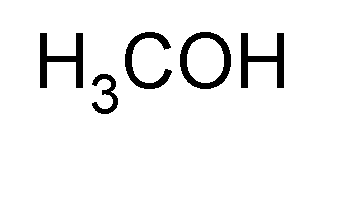Methyl Alcohol
»Methyl Alcohol contains not less than 99.5percent of CH3OH.
Packaging and storage—
Preserve in tight containers,remote from heat,sparks,and open flames.
Identification—
The IRabsorption spectrum of a thin film of it between potassium bromide plates or zinc selenide cells exhibits a broad,strong band at 2.7µm to 3.2µm,a strong maximum at about 3.4µm,a medium strong maximum at about 3.5µm,a weak region of absorption between 6.6µm and 7.6µm,and a very strong maximum at about 9.7µm.
Acidity—
Mix 25mLof water with 10mLof alcohol and 0.5mLof phenolphthalein TS,and add 0.02Nsodium hydroxide until a slight pink color persists after shaking for 30seconds.Taking precautions to avoid absorption of carbon dioxide,add 19mL(15g)of Methyl Alcohol,mix,and titrate with 0.020Nsodium hydroxide:not more than 0.45mLis required to produce a pink color.
Alkalinity (as ammonia)—
Mix 28.6mL(22.6g)of it with 25mLof water,add 1drop of methyl red TS,and titrate with 0.020Nsulfuric acid:not more than 0.20mLis required to produce a pink color (3ppm).
Water,Method Iá921ñ:
not more than 0.1%.
Readily carbonizable substances á271ñ—
Cool 5mLof sulfuric acid TS,contained in a small conical flask,to 10 ,and add 5mLof Methyl Alcohol dropwise with constant mixing,maintaining the temperature below 20
,and add 5mLof Methyl Alcohol dropwise with constant mixing,maintaining the temperature below 20 throughout the test:no discoloration develops.
throughout the test:no discoloration develops.
Nonvolatile residue—
Evaporate 250mLof it in a 600-mLbeaker on a steam bath,in a well-ventilated hood,until the volume is reduced to about 100mL.Cool,transfer a portion of the liquid to a suitable,tared 50-mLplatinum dish on a steam bath,evaporate,repeat the process until all of the liquid has been transferred,and evaporate to dryness.Dry at 105 for 30minutes,cool,and weigh:the weight of the residue does not exceed 2mg,corresponding to not more than 0.001%(w/w).
for 30minutes,cool,and weigh:the weight of the residue does not exceed 2mg,corresponding to not more than 0.001%(w/w).
Acetone and aldehydes (as acetone)—
Standard preparation—
Dilute 1.9mL(1.5g)of acetone with water to 1000mL,then dilute 1.0mLof this solution with water to 100mL,and mix.Dilute 2mLof the resulting solution with water to 5mL,and mix.The Standard preparationcontains 30µg of acetone,and is freshly prepared.
Test preparation—
Dilute 1.25mL(1g)of it with water to 5mL,and mix.
Procedure—
Adjust and maintain each solution at 20 .Add 5mLof alkaline mercuric-potassium iodide TSto the Standard preparationand to the Test preparation,and mix:any turbidity produced in the Test preparationis not greater than that produced in the Standard preparation(0.003%).
.Add 5mLof alkaline mercuric-potassium iodide TSto the Standard preparationand to the Test preparation,and mix:any turbidity produced in the Test preparationis not greater than that produced in the Standard preparation(0.003%).
Readily oxidizable substances—
Cool 20mLof it to 15 ,add 0.1mLof 0.1Npotassium permanganate,and allow to stand at 15
,add 0.1mLof 0.1Npotassium permanganate,and allow to stand at 15 :the pink color does not completely disappear within 5minutes.
:the pink color does not completely disappear within 5minutes.
Organic volatile impurities,Method IVá467ñ:
meets the requirements.
Assay—
Under typical conditions,the instrument is equipped with a flame-ionization detector and a 3-mm ×2-m stainless steel column packed with 50-to 80-mesh S4.The temperatures of the column,the injection port,and the detector are maintained at 140 ,220
,220 ,and 250
,and 250 ,respectively;and dry nitrogen is used as the carrier gas,at a flow rate of 20mLper minute.Inject about 1µLof Methyl Alcohol,and determine the peak responses by a convenient means.The retention time of methyl alcohol is about 2.5minutes and that of acetone is about 7minutes.Calculate the percentage of CH4Oin the Methyl Alcohol by dividing the response due to the methyl alcohol by the sum of the responses for all the peaks,and multiplying by 100.
,respectively;and dry nitrogen is used as the carrier gas,at a flow rate of 20mLper minute.Inject about 1µLof Methyl Alcohol,and determine the peak responses by a convenient means.The retention time of methyl alcohol is about 2.5minutes and that of acetone is about 7minutes.Calculate the percentage of CH4Oin the Methyl Alcohol by dividing the response due to the methyl alcohol by the sum of the responses for all the peaks,and multiplying by 100.
Auxiliary Information—
Staff Liaison:Karen A Russo,Ph.D.,Scientist
Expert Committee:(EMC)Excipients:Monograph Content
USP28–NF23Page 3036
Pharmacopeial Forum:Volume No.29(1)Page 150
Phone Number:1-301-816-8379
